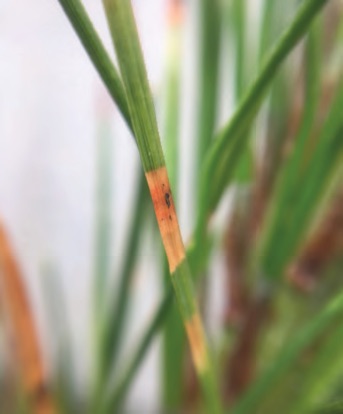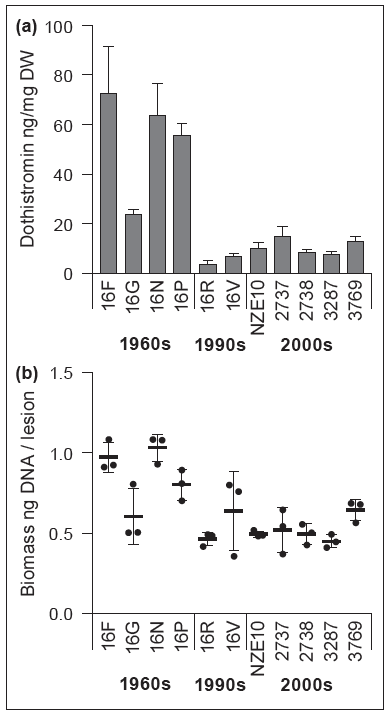PESTS AND DISEASES OF FORESTRY IN NEW ZEALAND
Reduced virulence of Dothistroma septosporum in New Zealand pine forests over 50 years
Scion is the leading provider of forest-related knowledge in New Zealand
Formerly known as the Forest Research Institute, Scion has been a leader in research relating to forest health for over 50 years. The Rotorua-based Crown Research Institute continues to provide science that will protect all forests from damage caused by insect pests, pathogens and weeds. The information presented below arises from these research activities.
From Forest Health News 295, December 2019.

Dothistroma septosporum was introduced into New Zealand approximately 50 years ago and the population has remained virtually clonal thanks to the lack of new incursions from overseas. The population thus presents a unique opportunity to determine if and how this pathogen has changed over time in NZ pine forests. In a recent paper by researchers at Massey University and Scion (Bradshaw et al 2019), D. septosporum cultures collected in the 1960s and stored in the Scion culture collection were compared with those from the 1990s and 2000s by whole-genome sequencing and phenotype analysis.
The group of 1960s isolates showed a low level of genetic diversity, suggesting that more than one isolate may have been introduced into the country, but that they were closely related. As expected, the genetic diversity increased over time due to natural mutation, but the genome sequences were still 99.999% identical.
From growth and spore germination assays, no evidence was found to suggest that copper fungicide treatments in NZ forests over the last 50 years have selected for increased copper tolerance in D. septosporum. Given that copper fungicide sprays are only used at most every 2–3 years, and only when certain thresholds of disease symptoms are exceeded, the selection pressure exerted by these anti-fungal compounds in the forest environment may be minimal compared to frequently-sprayed agricultural crops.

Remarkably, isolates from the 1960s showed significantly elevated virulence against Pinus radiata seedlings and produced higher levels of the virulence factor dothistromin in culture compared to isolates collected in the 1990s and 2000s (see Figure). Although the sample size was small due to limited numbers of suitable viable isolates from the 1960s, the results suggest that the NZ population of D. septosporum has become less virulent over time.
Whether the reduced virulence seen over time in this study reflects reduced virulence in the forest over five decades is not possible to assess. Many factors such as fungicide spraying regimes, tree genotypes and tree stocking rates, compounded by environmental influences, have affected disease levels observed in the forest and accurate long-term records of dothistroma needle blight are not available.
Regardless, D. septosporum appears to have changed over time in the NZ exotic forest environment despite its near clonal introduction event. Our hypothesis is that the long rotation times of forest crops could select for pathogen isolates that are not so aggressive that they kill their long-lived hosts. This could occur as a trade-off between pathogen virulence and transmission, in which highly aggressive pathogens that kill their hosts consequently have fewer opportunities to find a suitable new host.
This finding has implications for global forest health, suggesting the potential for incursions of highly virulent but clonal forest pathogens to become less virulent over time. Further, the implications for practical resistance breeding are that, in some situations, even low levels of resistance or tolerance might be sufficient for long-term tree health and survival.
Rosie Bradshaw Massey University
Bradshaw RE, Ormond S, Dupont P-Y, Chettri P, Ozturk IK, McDougal RL, Bulman LS, Cox MP (2019). Reduced virulence of an introduced forest pathogen over 50 years. Microorganisms 7: 420.
This information is intended for general interest only. It is not intended to be a substitute for specific specialist advice on any matter and should not be relied on for that purpose. Scion will not be liable for any direct, indirect, incidental, special, consequential or exemplary damages, loss of profits, or any other intangible losses that result from using the information provided on this site.
(Scion is the trading name of the New Zealand Forest Research Institute Limited.)

 Farm Forestry New Zealand
Farm Forestry New Zealand

